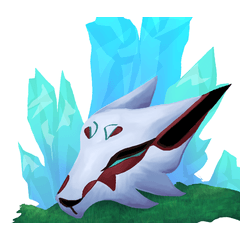用於顯示和隱藏草圖圖層的操作,無需滾動或按兩下小可見性方塊!為這些操作添加快捷方式以快速使用它們! Actions for showing and hiding sketch layers without scrolling or needing to click the small visibility square! Add shortcuts to these actions to use them quickly!
這是一個自動操作集,用於顯示和隱藏草圖圖層,而無需查找圖層、在視圖中滾動或按兩下非常小的可見性方塊!
您可以為這些操作添加快捷方式以快速使用它們!

為什麼要這樣做?

如果您有控制器或鍵盤,則使用物理按鈕 執行常見操作可能比查找專案並點擊螢幕上的小按鈕和框要容易得多。當您使用許多圖層並且它們之間間隔開來時尤其如此,並且滾動並找到需要切換的圖層變得更加困難。能見度按鈕也非常小!在沒有草圖的情況下經常檢查您的圖紙可以説明您更快地查看和調整最終圖紙!
首次設置
首先,導入動作集材質。
然後,設置快捷方式。
如果要新增鍵盤快速鍵:
- Windows:檔>快捷方式設定...> 類別: 自動操作- macOS/iOS:主應用程式選單>快捷方式設定...> 類別: 自動操作- 找到操作集的名稱,然後將快捷方式添加到所選取的顯示層次和隱藏層次操作。限度: Clip Studio Paint 的當前限制是“隱藏”和“顯示”需要是兩個單獨的操作,因此您需要兩個不同的快捷方式。讓我們希望他們將來可以消除限制,這樣切換就可以成為一種快捷方式。某些宏軟體可以自動在一個按鈕的兩個快捷方式之間切換。如果您的設備或軟體具有此功能,這將是一件好事。
可選取:您可以將它們添加到命令列或快速存取選項板
右鍵按下命令列,然後選擇[命令列設置...]然後在下拉清單中選擇[自動操作],找到所需的操作,併為每個操作選擇[添加]。完成後 [關閉]。您可以右鍵按兩下/點擊並按住按鈕,然後選擇[圖示設置...]以更改圖示。
如何使用
1. 將圖層命名為“草圖”
將圖層命名為「sketch」 將使其成為操作的目標。目標也可以是資料夾。確保內部圖層未同時命名為“草圖”(如果多個圖層的名稱相同,則該操作將僅針對與該名稱匹配的最低圖層。我還包含了針對名為“ref”或“%sketch”的圖層的操作。如果您想以不同的圖層名稱為目標,我在下面提供了有關如何錄製您自己的自動操作的說明。
2. 使用操作
使用熱鍵或快捷鍵顯示和隱藏草圖圖層!無需找到圖層或點擊小方塊!

這就是使用它所需的全部知識!
如果您需要更多快捷方式或想要使用其他圖層名稱,請繼續閱讀下面的內容!
-----
你可以用不同的名字錄製你自己的名字!
在 Clip Studio 畫圖中,自動動作功能可讓您錄製命令。
您可以在此處瞭解有關自動操作的更多資訊: HTTPs://www.youtube.com/watch?v=zMjJTB99sx0
您可以記錄自己的自動操作,這些操作會根據不同的圖層名稱目標進行顯示和隱藏!
例如,您可以隱藏並顯示名為「芥末」的層次,如下所示:

步驟:
1. 製作新的 Clip Studio Paint 插圖。2. 製作 2 個新的(空)自動操作,並將它們命名為顯示和隱藏。3. 建立一個新圖層作為目標圖層,並將其命名為您想要的名稱。4. 選擇其他層次。 這很重要!5. 選擇「隱藏」 操作。6. 開始錄製動作。 (點擊紅色錄製按鈕)7. 按下命名目標層次的可見性以將其隱藏。8. 停止錄製動作。 (點擊紅色停止按鈕)9. 使用「顯示層次」操作重複步驟 5 到 8,並記錄顯示目標圖層。
第4步很重要!您需要顯示或隱藏與所選圖層不同的層次。如果顯示/隱藏所選圖層,則會將操作的目標記錄為當前選定的圖層,而不是以特定圖層名稱為目標。
---
特別感謝teteotolis向我展示了乾淨的方法來做到這一點!
感謝您的支援!
您可以訪問我的 商店購買數百種其他 刷子!- @PharanBrush

This is an Auto-Action Set for showing and hiding sketch layers without needing to find the layer, scrolling it in view or clicking the really small visibility square!
You can add shortcuts to these actions to use them quickly!

Why this action?

If you have a controller or keyboard, it can be easier to use a physical button for common actions than having to find items and tap small on-screen buttons and boxes. This is especially true when you use many layers and they get spaced apart, and it gets harder to scroll and find the layer that you need to switch. The visibility button is also really small!Checking your drawing frequently without the sketch helps you see and adjust the final drawing faster!
First-time Setup
First, import the action set material.
Then, set the shortcuts.
If you want to add KEYBOARD SHORTCUTS:
- Windows: File > Shortcut Settings... > Category: Auto Actions- macOS/iOS: Main App Menu > Shortcut Settings... > Category: Auto Actions- Find the name of the action set and add shortcuts to the Show layer and Hide layer actions of your choice.Limitation: A current limitation of Clip Studio Paint is that "hide" and "show" need to be two separate actions so you need two different shortcuts. Let's hope they can remove limitation in the future so the toggle can just be one shortcut.Some macro software can automatically toggle between two shortcuts for one button. If your device or software has this feature, this would be a good thing to use for.
Optional: you can add them to the Command Bar or Quick Access palette
Right-click on the command bar and choose [Command Bar Settings...]Then choose [Auto Actions] in the dropdown, find the actions you want and choose [Add] for each. Then [Close] after you're done.You can right-click/tap-and-hold on the button and choose [Icon settings...] to change the icon.
How to use
1. Name your layer "sketch"
Naming your layer "sketch" will make it the target of the action.The target can also be a folder. Make sure the layer inside is not also named "sketch"(If you have multiple layers named the same, the action will only target the lowest layer that matches the name.)I've also included actions to target the layer named "ref" or "%sketch" instead. If you want to target a different layer name, I have instructions on how to record your own auto-action below.
2. Use the actions
Use the hotkeys or shortcuts to show and hide the sketch layer! No need to find the layer or tap on the little square!

That's all you need to know to use it!
If you need more shortcuts or want to use a different layer name, continue reading below!
-----
You can record your own with different names!
In Clip Studio Paint, the Auto-Actions feature lets you record commands.
You can learn more about auto actions here: https://www.youtube.com/watch?v=zMjJTB99sx0
You can record your own auto-actions that show and hide based on a different layer name target!
For example, you can hide and show a layer named "mustard" like this:

Steps:
1. Make a new Clip Studio Paint illustration.2. Make 2 new (empty) auto-actions and name them show and hide.3. Make a new layer as your target layer, and name it the name you want.4. Select a different layer. THIS IS IMPORTANT!5. Select the "hide" action.6. Start recording the action. (click the red record button)7. Click on the visibility of the named target layer to hide it.8. Stop recording the action. (click the red stop button)9. Repeat steps 5 to 8 with the "show layer" action and record showing the target layer instead.
STEP 4 is important! You need to show or hide a layer different from the one you have selected. If you show/hide the layer you have selected, it will record the target of the action as the currently selected layer instead of targeting a specific layer name.
---
Special thanks to teteotolis for showing me the clean way to do this was possible!
Thanks for your support!
You can visit my store for hundreds of other brushes! - @PharanBrush
















































